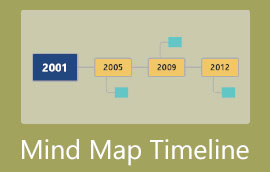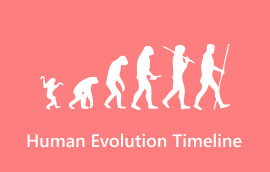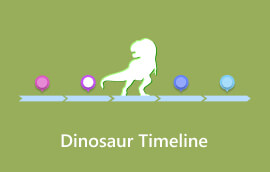Significant Periods in the Timeline of the Ice Ages
The Ice Age is one of the well-known events that happened in Earth’s history. As a matter of fact, scientists believe that we are still in the glacial age. Yet, it is less intense now. Some people wonder what the ice age is all about. While others are curious about what happened during that time. Fortunately, you are in this post. Read this guide as we’ve tackled the important information you might need. In addition, we listed and made a graphical representation of the timeline of the ice ages.

- Part 1. The Ice Age Overview
- Part 2. The Ice Age Timeline
- Part 3. Introduction to 5 Significant Ice Ages
- Part 4. FAQs About The Ice Age Timeline
Part 1. The Ice Age Overview
The Ice Age, also known as the Glacial Age, is a period that spanned millions of years. It refers to a phase in Earth's past when the climate was much colder. In fact, approximately one-third of the planet is covered by ice sheets. The Ice Age changed how the Earth looks. Repeated glacial advances and retreats mark this epoch. Big sheets of ice move and reshape the land by picking up rocks and dirt and wearing away hills. They're so heavy that they push down on the Earth's surface. When it gets colder near these ice areas, cold-weather plants have to move to warmer places in the south. The Ice Age comprises several distinct glaciations. It is also a testament to the planet's dynamic climate system and its ability to transform over vast timescales.
In modern times, the study of the Ice Age is essential for understanding Earth's climate history. Geological records such as ice cores and sediment layers hold vital clues to past climatic variations. This knowledge is instrumental in addressing contemporary climate change concerns and predicting future climate trends.
Part 2. The Ice Age timeline
Now that you have an introduction to Ice Age, turning it into a visual presentation will make your studies clearer. Now, check out the Ice Age timeline graph below.

Get a complete detail of the Ice Age timeline.
Bonus Tip. Best Timeline Maker
When making a timeline for a specific purpose, it is essential to choose the right tool. With the various timeline makers available today, MindOnMap stands out as the best one.
MindOnMap is a free online timeline maker. The program is designed to assist you in personalizing your diagram. It offers extensive features which you can use all for free! It provides pre-made templates, like organizational charts, treemaps, flowcharts, and more. Also, it enables you to add texts, shapes, pictures, links, etc., to your work. In that way, you’ll be able to make the diagram you need. To prevent data loss while working, the tool provides an auto-saving feature. Thus, every change you make will stay as it is. What’s more, MindOnMap lets you collaborate with your friends and others. As a result, many ideas will be put in your diagram. Now, you can access the app in different browsers, such as Chrome, Edge, Safari, and more. If you want to use it offline, you may also download it. To know more about its capability and features, try or install it now on your computer!
Secure Download
Secure Download

Did you know that there are 5 major and significant Ice Ages? To learn more about these ice ages, proceed to the next section of this post.
Part 3. Introduction to the 5 Significant Ice Ages
Throughout Earth's history, there have been five significant ice ages. Each marked distinct periods of widespread glaciation. Among these ice ages, the Quaternary Ice Age is presently ongoing. Before that, let’s go through the timeline of the ice ages in detail:
1. Huronian Ice Age (2.4 - 2.1 billion years ago)
This ice age is one of the earliest known, occurring during the Proterozoic Eon. Apart from being the first, it is also the longest one. At that point in history, Earth supported solely unicellular life forms. The temperatures plummeted to such extremes that the whole planet was covered in ice and snow. It was characterized as the Snowball Earth scenario.
2. Cryogenian Ice Age (720-635 million years ago)
The Earth’s next ice age is called the Cryogenian period. It went on for a very long time, approximately 200 million years. It is also considered one of the most severe of the five significant ice ages. During the Cryogenian period, the Earth experienced several ice ages with the most glaciations known as Sturtian and Marinoan. These events may have contributed to the emergence of complex multicellular life forms.
3. Andean-Saharan Ice Age (460-430 million years ago)
Following the Cryogenian period, the Earth went through the Andean-Saharan glaciation. This occurred about 450 to 420 million years ago and caused the first big major extinction of many creatures. This ice age took place during the Ordovician and Silurian periods. Glaciers covered parts of what are now Africa and South America. It had significant impacts on the planet's climate and sea levels.
4. Karoo Ice Age (360-260 million years ago)
The fourth significant ice age is the Karoo Ice Age. The event occurred during the Carboniferous and Permian periods around 360-260 million years ago. It also witnessed the next mass extinction of fauna and flora. Additionally, it led to the formation of vast ice sheets in the Southern Hemisphere. Thus, glaciation played a role in shaping the Earth's continents.
5. Quaternary Ice Age (2.58 million years ago)
It might be surprising, but right now, our Earth is in a glacial period. We are in the Quaternary Ice Age, which includes the Pleistocene period. This one began roughly 2.58 million years ago and is still happening, although it's not as cold as before. The most recent glacial period, often referred to as the Last Glacial Maximum (LGM), occurred around 20,000 years ago and had a significant impact on the planet's climate and geography.
Further Reading
Part 4. FAQs About The Ice Age Timeline
What stopped the ice age?
As noted above, our Earth is still in a glacial period but not as cool as before. So, the ice age has no straightforward cause ending. Many factors may have caused the ice age to end. It could be when northern latitudes receive increased sunlight, temperatures go up, causing the ice sheets to melt.
What came after the ice age?
After the Ice Age, the Stone Age followed. It earned its name because it was the time when early humans started using stones for tools and weapons. These early humans are often referred to as cavemen.
When did the ice age start and end?
The Ice Ages started approximately 2.4 million years ago and continued until around 11,500 years ago.
Conclusion
To conclude, the Earth's ice age timeline is interesting to learn. Thus, this post provides the necessary details you need to know. Apart from that, if you’re looking for a timeline maker, MindOnMap is the right one for you. The tool will give you all the freedom to generate your personalized timeline. With its editing options and straightforward interface, you can make a timeline with ease!











